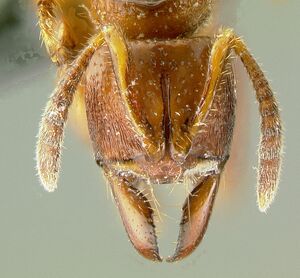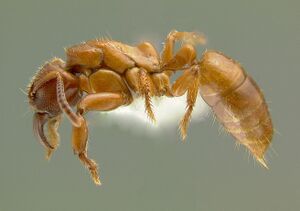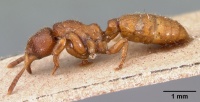Centromyrmex feae
| Centromyrmex feae | |
|---|---|

| |
| Scientific classification | |
| Kingdom: | Animalia |
| Phylum: | Arthropoda |
| Class: | Insecta |
| Order: | Hymenoptera |
| Family: | Formicidae |
| Subfamily: | Ponerinae |
| Tribe: | Ponerini |
| Genus: | Centromyrmex |
| Species: | C. feae |
| Binomial name | |
| Centromyrmex feae (Emery, 1889) | |
| Subspecies | |
| |
| Synonyms | |
| |
Centromyrmex feae is a subterranean species occurring in forest habitats. Workers are often collected from rotting logs and termite mounds, suggesting C. feae is termitophagous. (Eguchi 2014)
Photo Gallery
Identification
A member of the feae species group / Key to Centromyrmex species groups
Distribution
Latitudinal Distribution Pattern
Latitudinal Range: 19.11666667° to -7.491667°.
| North Temperate |
North Subtropical |
Tropical | South Subtropical |
South Temperate |
- Source: AntMaps
Distribution based on Regional Taxon Lists
Indo-Australian Region: Philippines.
Oriental Region: Cambodia, India, Laos, Myanmar (type locality), Sri Lanka, Taiwan, Thailand, Vietnam.
Palaearctic Region: China.
Distribution based on AntMaps
Distribution based on AntWeb specimens
Check data from AntWeb
Countries Occupied
| Number of countries occupied by this species based on AntWiki Regional Taxon Lists. In general, fewer countries occupied indicates a narrower range, while more countries indicates a more widespread species. |

|
Estimated Abundance
| Relative abundance based on number of AntMaps records per species (this species within the purple bar). Fewer records (to the left) indicates a less abundant/encountered species while more records (to the right) indicates more abundant/encountered species. |

|
Biology
Castes
Worker
    
| |
| . | |
Nomenclature
The following information is derived from Barry Bolton's Online Catalogue of the Ants of the World.
- feae. Spalacomyrmex feae Emery, 1889b: 491, pl. 10, figs. 11-15 (w.) MYANMAR.
- Type-material: syntype workers (number not stated) .
- Type-localities: Myanmar (“Burma”): Bhamo, 1885-87 (L. Fea), Myanmar: Shwegoo, 1885-87 (L. Fea), Myanmar: Prome, 1885-87 (L. Fea).
- Type-depository: MSNG.
- [Misspelled as feai by Emery, 1893f: 240.]
- Forel, 1900d: 303 (q.); Wheeler, W.M. 1936d: 207 (m.); Wheeler, G.C. & Wheeler, J. 1952c: 604 (l.); Imai, et al. 1984: 5 (k.).
- Combination in Centromyrmex: Emery, 1890b: 40 (footnote).
- Status as species: Dalla Torre, 1893: 16; Emery, 1893f: 240; Emery, 1895k: 456; Forel, 1900d: 303; Bingham, 1903: 94; Emery, 1911d: 58; Wheeler, W.M. 1913e: 233; Forel, 1913f: 184; Forel, 1913k: 6; Wheeler, W.M. & Chapman, 1925: 61; Karavaiev, 1925a: 81; Wheeler, W.M. 1927h: 83; Wheeler, W.M. 1928c: 4; Wheeler, W.M. 1929g: 58; Wheeler, W.M. 1930h: 58; Wheeler, W.M. 1936d: 206; Chapman & Capco, 1951: 52; Baltazar, 1966: 241; Bolton, 1995b: 140; Tang, J., Li, et al. 1995: 33; Zhou, 2001b: 28; Lin & Wu, 2003: 67; Jaitrong & Nabhitabhata, 2005: 17; Bolton & Fisher, 2008c: 25; Terayama, 2009: 108; Zhou & Ran, 2010: 103; Guénard & Dunn, 2012: 58; Bharti, Guénard, et al. 2016: 49; Jaitrong, Guénard, et al. 2016: 40; Dias, R.K.S. et al. 2020: 105; Khachonpisitsak, et al. 2020: 141.
- Senior synonym of donisthorpei: Brown, 1955f: 103; Bolton, 1995b: 140; Zhou, 2001b: 28; Bolton & Fisher, 2008c: 25.
- Current subspecies: nominal plus ceylonicus, greeni.
- Distribution
- Malesian: Indonesia (Java), Philippines (Basilan, Luzon, Mindanao), Singapore.
- Oriental: China, India, Laos, Myanmar, Sri Lanka, Taiwan, Thailand, Vietnam.
- donisthorpei. Centromyrmex donisthorpei Menozzi, 1925c: 443, fig. 4 (q.) PHILIPPINES (Mindanao).
- Type-material: 2 syntype queens.
- Type-localities: Philippines: Mindanao, Iligan (no. 19444) (C.F. Baker); Philippines: Mindanao, Kolambugan (C.F. Baker).
- Type-depository: IEUB.
- Status as species: Chapman & Capco, 1951: 52; Baltazar, 1966: 241.
- Junior synonym of feae: Brown, 1955f: 103; Bolton, 1995b: 140; Zhou, 2001b: 28; Bolton & Fisher, 2008c: 25.
Unless otherwise noted the text for the remainder of this section is reported from the publication that includes the original description.
Description
Rufo-testacea, nitida, haud pubescens, pilis setiformibus, curvatis hirsuta. Caput subquadratum, punctis foveiformibus, magnis, piligeris sparse impressum (infra postice sine punctis), linea frontali profunda, postice abbreviata, genis longitudinaliter rugulosis. Mandibulae laeves, sparse, subtilissime punctatae, mat'gine masticatorio circiter 12-denticulato, basi sulco obliquo in margine externo evanescente (fere ut in Ponera sulcata et affinibus). Clypeus lateribus subtiliter rugoso-punctatus, impressione media laevi. Antennarum flagelli articulus 1 longitudine duorum sequentium, 2-7 breviores quam crassiores, ultimus longitudine duorum praecedentium. Thorax pronoti disco curvatim rugoso, mesonoti dorso planato, grosse punctato, metanoto fere sine punctis magnis, sed subtilissime reticulato, subopaco, superficie declivi convexa, nitida, sublaevi. Pedunculus et abdomen nitida, punctis piligeris subtilioribus. Pedes nitidi, punctis piligeris. Long. 4 1/2-5 mm.
Worker
Bingham (1903): Entirely yellow, with a brownish or reddish tinge, covered sparsely with short erect pale hairs, which are more densely set towards the apex o£ the abdomen beneath. Head, thorax and abdomen with the characters of the genus. Head posteriorly, the pro- and mesonotum rather sparingly but coarsely punctured ; the mandibles, metanotum, coxae, femora and tibiae of the legs, node of pedicel, and abdomen smooth, polished, shining; the pronotum along the crescentic anterior margin with a broad but slight depression, which is finely wrinkled.
Length: 3.5 - 4 mm
Karyotype
- n = 22, 2n = 44, karyotype = 14M+30A (India) (Imai et al., 1984; Mariano et al., 2015).
References
- Brown, W. L., Jr. 1955f. The ant Centromyrmex donisthorpei Menozzi, a synonym. Psyche (Camb.) 62: 103 (page 103, Senior synonym of donisthorpei)
- Dias, R.K.S., Rajapaksa, R.P.K.C. 2017. Geographic records of subfamilies, genera and species of ants (Hymenoptera: Formicidae) in the four climatic zones of Sri Lanka: A review. Journal of Science of the University of Kelaniya Sri Lanka 11, 23-45. (doi:10.4038/josuk.v11i2.7999).
- Eguchi, K., Bui, T.V. and Yamane, S. 2014. Generic Synopsis of the Formicidae of Vietnam (Insecta: Hymenoptera), Part II - Cerapachyinae, Aenictinae, Dorylinae, Leptanillinae, Amblyoponinae, Ponerinae, Ectatomminae and Ponerinae. Zootaxa. 3860:1–46.
- Emery, C. 1889c. Formiche di Birmania e del Tenasserim raccolte da Leonardo Fea (1885-87). [part]. Ann. Mus. Civ. Stor. Nat. 27[=(2)(7): 485-512 (page 491, pl. 10, figs. 11-15 worker described)
- Emery, C. 1890c. Studii sulle formiche della fauna neotropica. Bull. Soc. Entomol. Ital. 22: 38-80 (page 40, (footnote) Combination in Centromyrmex)
- Forel, A. 1900f. Les Formicides de l'Empire des Indes et de Ceylan. Part VII. J. Bombay Nat. Hist. Soc. 13: 303-332 (page 303, queen, male described)
- General, D.E.M., Buenavente, P.A.C., Rodriguez, L.J.V. 2020. A preliminary survey of nocturnal ants, with novel modifications for collecting nocturnal arboreal ants. Halteres 11: 1-12 (doi:10.5281/ZENODO.3707151).
- Imai, H. T.; Baroni Urbani, C.; Kubota, M.; Sharma, G. P.; Narasimhanna, M. H.; Das, B. C.; 1984. Karyological survey of Indian ants. Jpn. J. Genet. 59: 1-32 (page 5, karyotype described)
- Khachonpisitsak, S., Yamane, S., Sriwichai, P., Jaitrong, W. 2020. An updated checklist of the ants of Thailand (Hymenoptera, Formicidae). ZooKeys 998, 1–182 (doi:10.3897/zookeys.998.54902).
- Liu, C., Fischer, G., Hita Garcia, F., Yamane, S., Liu, Q., Peng, Y.Q., Economo, E.P., Guénard, B., Pierce, N.E. 2020. Ants of the Hengduan Mountains: a new altitudinal survey and updated checklist for Yunnan Province highlight an understudied insect biodiversity hotspot. ZooKeys 978, 1–171 (doi:10.3897/zookeys.978.55767).
- Mariano, C.S.F., Santos, I.S., Silva, J.G., Costa, M.A., Pompolo, S.G. 2015. Citogenética e evolução do cariótipo em formigas poneromorfas. In: Delabie, J.H.C., Feitosa, R.M., Serrao, J.E., Mariano, C.S.F., Majer, J.D. (eds) As formigas poneromorfas do Brasil, 1st edn. Ilhéus, Brasil, pp 102–125 (doi:10.7476/9788574554419.0010).
- Bolton, B. and B. L. Fisher. 2008c. Afrotropical ants of the ponerine genera Centromyrmex Mayr, Promyopias Santschi gen. rev. and Feroponera gen. n., with a revised key to genera of African Ponerinae (Hymenoptera: Formicidae). Zootaxa 1929: 1-37. PDF
- Subedi, I.P., Budha, P.B., Bharti, H., Alonso, L., Yamane, S. 2023. Ponerine ants of Nepal (Hymenoptera: Formicidae, Ponerinae): a generic synopsis, new faunal records, and rediscovery of a rare ant, Emeryopone franzi (Baroni Urbani 1975). (doi:10.20362/am.016003).
- Wang, W.Y., Soh, E.J.Y., Yong, G.W.J., Wong, M.K.L., Benoit Guénard, Economo, E.P., Yamane, S. 2022. Remarkable diversity in a little red dot: a comprehensive checklist of known ant species in Singapore (Hymenoptera: Formicidae) with notes on ecology and taxonomy. Asian Myrmecology 15: e015006 (doi:10.20362/am.015006).
- Wheeler, G. C.; Wheeler, J. 1952c. The ant larvae of the subfamily Ponerinae - Part II. Am. Midl. Nat. 48: 604-672 (page 604, larva described)
- Wheeler, W. M. 1936e. Ecological relations of ponerine and other ants to termites. Proc. Am. Acad. Arts Sci. 71: 159-243 (page 207, male described)
- Yamane, S., Tanaka, H.O., Hasimoto, Y., Ohashi, M., Meleng, P., Itioka, T. 2021. A list of ants from Lambir Hills National Park and its vicinity, with their biological information: Part II. Subfamilies Leptanillinae, Proceratiinae, Amblyoponinae, Ponerinae, Dorylinae, Dolichoderinae, Ectatomminae and Formicinae. Contributions from the Biological Laboratory, Kyoto University 31, 87–157.
References based on Global Ant Biodiversity Informatics
- Chapman, J. W., and Capco, S. R. 1951. Check list of the ants (Hymenoptera: Formicidae) of Asia. Monogr. Inst. Sci. Technol. Manila 1: 1-327
- Chen Y., C. W. Luo, H. W. Li, Y. J. Liu, H. F. Zheng, and F. C. Yang. 2013. Investigation of ant species and distribution on Wuliang Mountain. Journal of Henan Agricultural Sciences 42(5): 118-122.
- Dad J. M., S. A. Akbar, H. Bharti, and A. A. Wachkoo. 2019. Community structure and ant species diversity across select sites ofWestern Ghats, India. Acta Ecologica Sinica 39: 219–228.
- Dias R. K. S. 2002. Current knowledge on ants of Sri Lanka. ANeT Newsletter 4: 17- 21.
- Dias R. K. S. 2006. Current taxonomic status of ants (Hymenoptera: Formicidae) in Sri Lanka. The Fauna of Sri Lanka: 43-52. Bambaradeniya, C.N.B. (Editor), 2006. Fauna of Sri Lanka: Status of Taxonomy, Research and Conservation. The World Conservation Union, Colombo, Sri Lanka & Government of Sri Lanka. viii + 308pp.
- Dias R. K. S., K. R. K. A. Kosgamage, and H. A. W. S. Peiris. 2012. The Taxonomy and Conservation Status of Ants (Order: Hymenoptera, Family: Formicidae) in Sri Lanka. In: The National Red List 2012 of Sri Lanka; Conservation Status of the Fauna and Flora. Weerakoon, D.K. & S. Wijesundara Eds., Ministry of Environment, Colombo, Sri Lanka. p11-19.
- Dias R. K. S.; Perera K. A. M. 2011. Worker ant community observed by repeated sampling and information on endemic Aneuretus simoni Emery in the Gilimale Forest Reserve in Sri Lanka. Asian Myrmecology 4: 69-78.
- Eguchi K., B. T. Viet, and S. Yamane. 2014. Generic Synopsis of the Formicidae of Vietnam (Insecta: Hymenoptera), Part IICerapachyinae, Aenictinae, Dorylinae, Leptanillinae, Amblyoponinae, Ponerinae, Ectatomminae and Proceratiinae. Zootaxa 3860: 001-046.
- Emery C. 1889. Formiche di Birmania e del Tenasserim raccolte da Leonardo Fea (1885-87). Annali del Museo Civico di Storia Naturale 27: 485-520.
- Emery C. 1893. Voyage de M. E. Simon à l'île de Ceylan (janvier-février 1892). Formicides. Annales de la Société Entomologique de France 62: 239-258.
- Forel A. 1900. Les Formicides de l'Empire des Indes et de Ceylan. Part VII. J. Bombay Nat. Hist. Soc. 13: 303-332.
- Forel A. 1913. H. Sauter's Formosa-Ausbeute: Formicidae II. Arch. Naturgesch. (A)79(6): 183-202
- Forel A. 1913k. Wissenschaftliche Ergebnisse einer Forschungsreise nach Ostindien ausgeführt im Auftrage der Kgl. Preuss. Akademie der Wissenschaften zu Berlin von H. v. Buttel-Reepen. II. Ameisen aus Sumatra, Java, Malacca und Ceylon. Gesammelt von Herrn Prof. Dr. v. Buttel-Reepen in den Jahren 1911-1912. Zoologische Jahrbücher. Abteilung für Systematik, Geographie und Biologie der Tiere 36:1-148.
- Guénard B., and R. R. Dunn. 2012. A checklist of the ants of China. Zootaxa 3558: 1-77.
- Hashimoto Y., and M. Mohamed. 2011. Ground-dwelling ant diversity in Maliau Basin, Borneo: evaluation of hand-sorting methods to estimate ant diversity. Tropics 19(2): 85-92.
- Hu C.-H. 2006. Indigenized conservation and biodiversity maintenance on Orchid Island. PhD Thesis, graduate school of the University of Minnesota. 150 pages.
- IZIKO South Africa Museum Collection
- Ito, F.; Yamane, S.; Eguchi, K.; Noerdjito, W. A.; Kahono, S.; Tsuji, K.; Ohkawara, K.; Yamauchi, K.; Nishida, T.; Nakamura, K. 2001. Ant species diversity in the Bogor Botanic Garden, West Java, Indonesia, with descriptions of two new species of the genus Leptanilla (Hymenoptera, Formicidae). Tropics 10:379-404.
- Jaitrong W., B. Guenard, E. P. Economo, N. Buddhakala, and S. Yamane. 2016. A checklist of known ant species of Laos (Hymenoptera: Formicidae). Asian Myrmecology 8: 1-32. DOI: 10.20362/am.008019
- Jaitrong W., and T. Ting-Nga. 2005. Ant fauna of Peninsular Botanical Garden (Khao Chong), Trang Province, Southern Thailand (Hymenoptera: Formicidae). The Thailand Natural History Museum Journal 1(2): 137-147.
- Karavaiev V. 1926. Ameisen aus dem Indo-Australischen Gebiet. Treubia 8: 413-445.
- Karavaiev, V. 1925. Ponerinen (Fam. Formicidae) aus dem Indo-Australischen Gebiet. Konowia 4:69-81.
- Li Z.h. 2006. List of Chinese Insects. Volume 4. Sun Yat-sen University Press
- Liu H., X.Z. Yuan, C.D. Zhang. 2002. Community structure and species diversity of ant in Qufu, Shandong province. Biodiversity Science 10(3): 298-304.
- Musthak Ali T. M. 1991. Ant Fauna of Karnataka-1. Newsletter of IUSSI Indian Chapter 5(1-2): 1-8.
- Nair V. M. 2011. First record of the ant, Centromyrmex feae Emery, 1889 (subfamily Ponerinae) from Mangalore district, Karnataka. Bugs R All (Newsletter of the Invertebrate Conservation & Information Network of South Asia) 17: 22.
- Ogata K. 2005. Asian ant inventory and international networks. Report on Insect inventory Project in Tropic Asia TAIIV: 145-170.
- Parui A. K., S. Chatterjee, and P. Basu. 2015. Habitat characteristics shaping ant species assemblages in a mixed deciduous forest in Eastern India. Journal of Tropical Ecology: 1-14. doi:10.1017/S0266467415000036
- Sakchoowong W., W. Jaitrong, and K. Ogata. 2008. Ant diversity in forest and traditional hill-tribe agricultural types in northern Thailand. Kasetsart J. (Nat. Sci.) 42: 617-626.
- Song Y., Z. Xu, C. Li, N. Zhang, L. Zhang, H. Jiang, and F. Mo. 2013. An Analysis on the Ant Fauna of the Nangun river Nature Reserve in Yunnan, China. Forest Research 26(6): 773-780.
- Tang J., Li S., Huang E., Zhang B. and Chen Y.. 1995. Hymenoptera: Formicidae (1). Economic Insect Fauna of China 47: 1-133.
- Terayama M. 2009. A synopsis of the family Formicidae of Taiwan (Insecta: Hymenoptera). Research Bulletin of Kanto Gakuen University. Liberal Arts 17:81-266.
- Terayama, M. 2009. A synopsis of the family Formicidae of Taiwan (Insecta; Hymenoptera). The Research Bulletin of Kanto Gakuen University 17: 81-266.
- Tiwari R.N., B.G. Kundu, S. Roychowdhury, S.N. Ghosh. 1999. Insecta: Hymenoptera: Formicidae. Pp. 211-294 in: Director; Zoological Survey of India (ed.) 1999. Fauna of West Bengal. Part 8. Insecta (Trichoptera, Thysanoptera, Neuroptera, Hymenoptera and Anoplura). Calcutta: Zoological Survey of India, iv + 442 pp.
- Wheeler W. M. 1913. Zoological results of the Abor Expedition, 1911-1912, XVII. Hymenoptera, II: Ants (Formicidae). Records of the Indian Museum 8: 233-237.
- Wheeler W. M. 1927. Ants collected by Professor F. Silvestri in Indochina. Bollettino del Laboratorio di Zoologia Generale e Agraria della Reale Scuola Superiore d'Agricoltura. Portici 20: 83-106.
- Wheeler W. M. 1928. Ants collected by Professor F. Silvestri in China. Bollettino del Laboratorio di Zoologia Generale e Agraria della Reale Scuola Superiore d'Agricoltura. Portici 22: 3-38.
- Wheeler W. M. 1929. Ants collected by Professor F. Silvestri in Formosa, the Malay Peninsula and the Philippines. Bollettino del Laboratorio di Zoologia Generale e Agraria della Reale Scuola Superiore d'Agricoltura. Portici 24: 27-64.
- Wheeler W. M. 1930. A list of the known Chinese ants. Peking Natural History Bulletin 5: 53-81.
- Wheeler W. M., and J. W. Chapman. 1925. The ants of the Philippine Islands. Part I, Dorylinae and Ponerinae. Philipp. J. Sci. 28: 47-73.
- Xu Z. H., B. L. Yang, and G. Hu. 1999. Formicidae ant communities in fragments of montane rain forest in Xishuangbanna, China. Zoological Research 20(4): 288-293.
- Xu Z. 1999. [An analysis on the ant fauna of the tropical rain forest in Xishuangbanna of China.] Zoological Research 20: 379-384.
- Yamane S.; Bui T. V.; Ogata K.; Okido H.; Eguchi K. 2002. Ant fauna of Cuc Phuong National Park, North Vietnam (Hymenoptera: Formicidae). Bulletin of the Institute of Tropical Agriculture Kyushu University 25: 51-62.
- Zhou S.-Y. 2001. Ants of Guangxi. Guangxi Normal University Press, Guilin, China, Guilin, China. 255 pp.
- Zryanin V. A. 2011. An eco-faunistic review of ants (Hymenoptera: Formicidae). In: Structure and functions of soil communities of a monsoon tropical forest (Cat Tien National Park, southern Vietnam) / A.V. Tiunov (Editor). – M.: KMK Scientific Press. 2011. 277 р.101-124.




